

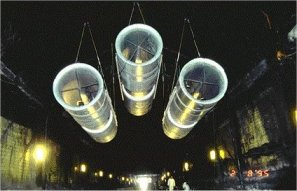 Historically, tunnel ventilation systems were designed to maintain
acceptable levels of pollutants. Oversizing usually resulted, as a
consequence of the need to cope with congested traffic conditions,
and this had the benefit that a satisfactory air flow could be
maintained in the event of a fire. Now things have changed: vehicle
emissions have reduced, safety has become more important and the
energy costs associated with ventilation must be minimised. As a
consequence, there is a need for much more precise design to ensure
that smoke diffusion is controlled while people are evacuated from
the tunnel. In particular, the control of back-layering phenomena
represents a crucial factor in efficient design methodologies.
Historically, tunnel ventilation systems were designed to maintain
acceptable levels of pollutants. Oversizing usually resulted, as a
consequence of the need to cope with congested traffic conditions,
and this had the benefit that a satisfactory air flow could be
maintained in the event of a fire. Now things have changed: vehicle
emissions have reduced, safety has become more important and the
energy costs associated with ventilation must be minimised. As a
consequence, there is a need for much more precise design to ensure
that smoke diffusion is controlled while people are evacuated from
the tunnel. In particular, the control of back-layering phenomena
represents a crucial factor in efficient design methodologies.
A number of experimental studies have been carried out and there is now the possibility of using the results to refine the simulation of tunnel flows in terms of air flow, temperature and smoke diffusion. Here, the PHOENICS CFD software is used to simulate the full-scale Memorial Tunnel Fire Ventilation Test Programme. The work was carried out by the University of Rome, in conjunction with ENEA - the Italian Agency for Energy, New Technology and the Environment.
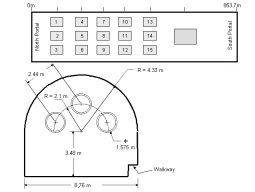 The Memorial Tunnel is a two-lane, 853m long, straight motorway
gallery with a medium slope of 3.2% from north to south portal;
the tunnel has a cross-section of 60.4m2. Various
ventilation configurations were used for the experiments, but the
simulations concentrate on the longitudinal system: 15 jet-fans
were placed inside the tunnel, in groups of 3. The jet fans
induced an air velocity of 34.2m/s and a mass flow rate of
43m3/s.
The Memorial Tunnel is a two-lane, 853m long, straight motorway
gallery with a medium slope of 3.2% from north to south portal;
the tunnel has a cross-section of 60.4m2. Various
ventilation configurations were used for the experiments, but the
simulations concentrate on the longitudinal system: 15 jet-fans
were placed inside the tunnel, in groups of 3. The jet fans
induced an air velocity of 34.2m/s and a mass flow rate of
43m3/s.
Fuel pans were placed about 240m from the south portal to simulate a fire, with a total heat release was about 10MW. Several tests were carried out, with various combinations of active fans.
A preliminary cold flow simulation was carried out to assess the code settings, such as wall roughness and swirl effects created by the fans. The calculated flow through the tunnel was about 10% below the measured value; this was acceptable, given the simplifications in the modeling and the uncertainty in the experimental set-up.
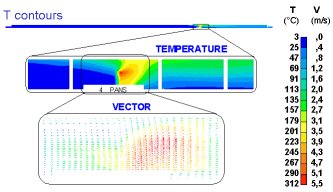 Fire simulations are often carried out without radiation modelling:
the heat source associated with the fire is reduced to allow for
the heat that is, in reality, transferred by radiation, but the
detail of that heat transfer is ignored. In this case simulations
were carried out both with and without radiation, making use of
the IMMERSOL model in PHOENICS. Comparisons with data at monitoring
locations showed that both approaches were able to predict the
presence of a back-layering region near the ceiling, but only in
the IMMERSOL case were the values in accordance with experiment.
This aspect is of crucial relevance: a misrepresentation of the
back-layering phenomenon in flows near the critical conditions
could give a completely wrong prediction of the ventilation
efficiency in controlling the smoke diffusion.
Fire simulations are often carried out without radiation modelling:
the heat source associated with the fire is reduced to allow for
the heat that is, in reality, transferred by radiation, but the
detail of that heat transfer is ignored. In this case simulations
were carried out both with and without radiation, making use of
the IMMERSOL model in PHOENICS. Comparisons with data at monitoring
locations showed that both approaches were able to predict the
presence of a back-layering region near the ceiling, but only in
the IMMERSOL case were the values in accordance with experiment.
This aspect is of crucial relevance: a misrepresentation of the
back-layering phenomenon in flows near the critical conditions
could give a completely wrong prediction of the ventilation
efficiency in controlling the smoke diffusion.
The simulations demonstrated the capability of the PHOENICS software to simulate tunnel fires and to predict the observed flow behaviour. This provides safety engineers with a powerful tool in the design of ventilation systems that will enhance safety while keeping down costs.
The Memorial Tunnel is a two-lane, 853m long, straight motorway gallery with a medium slope of 3.2% from north to south portal; the tunnel has a cross-section of 60.4m2. Various ventilation configurations were used for the experiments, but the simulations concentrate on the longitudinal system: 15 jet-fans were placed inside the tunnel, in groups of 3. The jet fans induced an air velocity of 34.2m/s and a mass flow rate of 43m3/s.
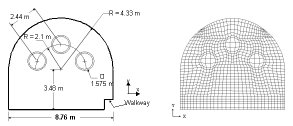 A body-fitted-coordinate (BFC) grid was constructed to
represent adequately all the objects in the tunnel
(jet-fans, measurement instruments, fuel pans). 324000 cells
were used, with 326 in the axial direction. The built-in GCV
(Generalised Collocated Velocity) approach was adopted.
A body-fitted-coordinate (BFC) grid was constructed to
represent adequately all the objects in the tunnel
(jet-fans, measurement instruments, fuel pans). 324000 cells
were used, with 326 in the axial direction. The built-in GCV
(Generalised Collocated Velocity) approach was adopted.
The portals were treated as fixed pressure boundaries, with air at a temperature of 2.8�C being convected in. The tunnel wall temperatures were assumed to be known: 12.8�C at the sides and 85�C (near the fire) to 30�C (near the portals) along the top.
The working fans have a thrust of 1748N and were simulated by an imposed velocity of 36.5m/s, surrounded by a solid shield. A swirl velocity of half the axial velocity was also applied. Inactive fans were simulated as an adiabatic blockage.
The simulation was steady-state and had to take account of
the key physical phenomena:
- turbulence;
- buoyancy phenomena generated by the fire;
- heat and smoke release at the fire;
- radiative heat transfer.
The air was treated as an ideal gas and turbulence effects were modelled using the k-e model. The pan used for the fire was, in reality, filled with a water layer on which the burning fuel oil floated. The combustion process was not considered in the simulations, which used a fixed volumetric heat source. Simulations with and without radiation were carried out. In accordance with normal practice, the heat source was reduced by 30% in the non-radiation case (6.36MW compared with 9.61MW). For radiation modelling the built-in IMMERSOL method was used.
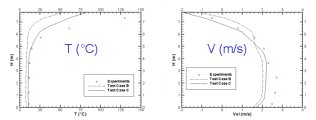 Comparison with data was possible at many monitoring locations.
The figure shows velocity and temperature profiles just upstream
of the fire for the two modelling approaches: Test Case B treats
radiation simply by reducing the heat source associated with the
fire, while Test Case C uses the IMMERSOL radiation model in
PHOENICS. The presence of a back-layering region near the
ceiling is predicted by both simulations, but only in Test
Case C are the values are in accordance with experiment.
Comparison with data was possible at many monitoring locations.
The figure shows velocity and temperature profiles just upstream
of the fire for the two modelling approaches: Test Case B treats
radiation simply by reducing the heat source associated with the
fire, while Test Case C uses the IMMERSOL radiation model in
PHOENICS. The presence of a back-layering region near the
ceiling is predicted by both simulations, but only in Test
Case C are the values are in accordance with experiment.